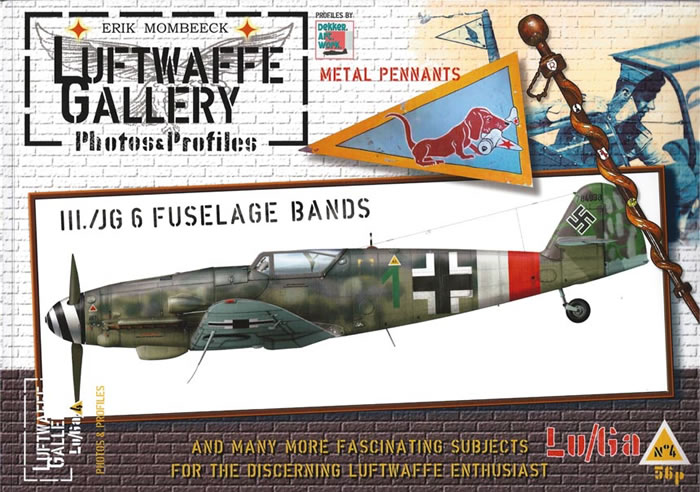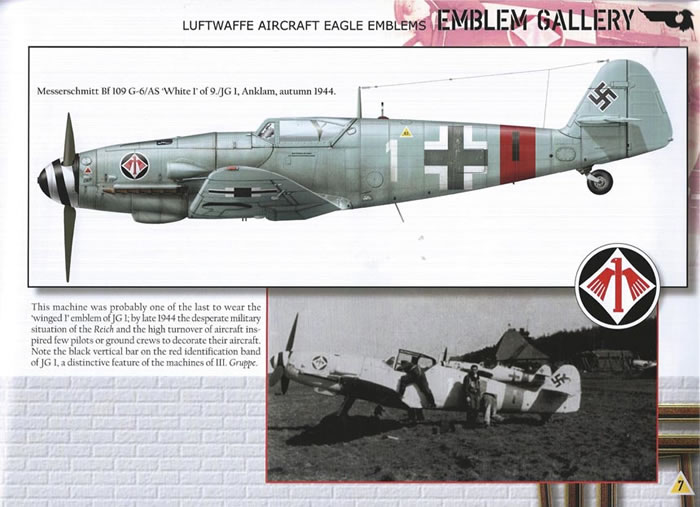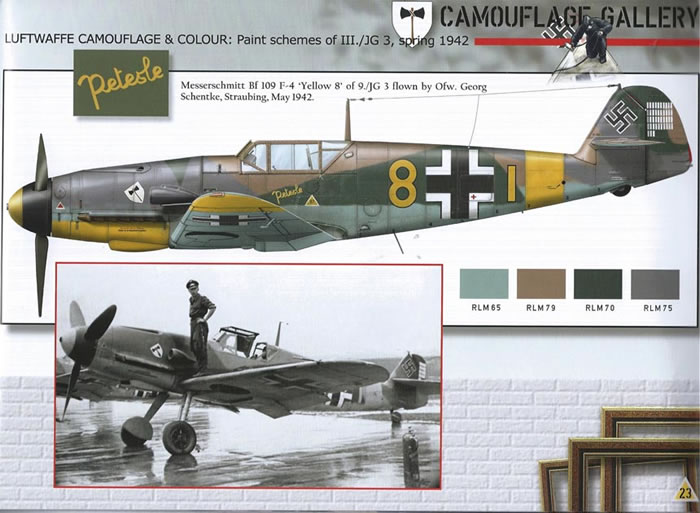Luftwaffe Gallery No.4
Photos & Profiles

by Erik Mombeek
Profile Artwork by Thierry Dekker
S u m m a r y |
Publication Details: |
Luftwaffe Gallery No. 4 – Photos & Profiles
by
Erik Mombeek. Profiles by Thierry Dekker
|
| ISBN: |
978-2-930546-12-4 |
Media and Contents: |
Soft cover; Landscape A4 format; 56 pages plus covers. |
Price: |
Europe - 25€ includes postage. Rest of World - $38 includes postage. |
Review Type: |
FirstRead |
Advantages: |
Excellent pictures, some in color, and profiles and English text. |
Disadvantages: |
Need for better explanatory text |
Conclusion: |
This one is a definite must have for the Luftwaffe enthusiast. |
Reviewed by Rob Baumgartner

HyperScale is proudly supported by Squadron
This is the fourth edition in the Luftwaffe Gallery series from Erik Mombeek. As with previous editions in this series, it is a compilation of snippets of information on various Luftwaffe matters organized around a common theme.
There is a balanced mix of excellent profiles, by Thierry Dekker, and photographs. Thankfully, the profiles are backed up with a photograph of the subject of the profile. I, for one, appreciate the ability to interpret and evaluate the subject for myself. To often, profiles are presented without photographic support.
The profiles and photographs are well captioned with explanatory text. But, the text can be a weak point of this monograph. Sometimes, the text fails to fully explain a key point or points in the presentation.

There is a note in the preface that the text was translated into English from French, but I am not sure if that is the root of the problem.
This edition is divided into six galleries, each addressing a different subject matter.
EMBLEM GALLERY:
In this gallery a number of Luftwaffe emblems that include the eagle in the design are examined. While the selection may seem random, the flow, at least to me, seems to take a logical progression.
There is JG 1, where the unit’s numerical designation is used to create the eagle. Then on to JFS 4 (Jagdfliegerschule), where the eagle becomes a bit more aggressive. This aggressive eagle motif is picked up with ZG 76, NJG 1 and KG 30.
It is the caption for the picture of a KG 30 aircraft that is an example of explanations that fall short. While the author digresses to discuss the Luftwaffe code system, and why the “D” is white (7. Staffel, white staffel color), he does not explain the reason for the yellow color of the emblem on which the eagle is pictured. For the aircraft in question, 4D+DR, it is part of III Gruppe, and this gruppe color is yellow. Another picture shows an emblem with what appears to be a red background, but not indicated as such. It would have been more beneficial to explain the issue at hand, the emblem, rather than the coding.
This gallery continues with the heraldic style eagle used in the emblems of JG 54, JG 5, St. G. 2 and St. G 1.
CAMOUFLAGE GALLERY:
Here the author takes a look at the Bf 109F-4 aircraft of III JG 3. These are in a most unique scheme. It seems these aircraft were intended for the Mediterranean Theatre, but were diverted to the Eastern Front, and, therefor, apparently had a factory applied RLM 79 top color, over which other colors were applied.

The gallery’s captions, however, focus more on the pilots than the issues surrounding the scheme. One issue of contention will be the color that was on the underside. The Camouflage Gallery indicates, in very well done profiles, that it is RLM 65. However, in an on line pdf. article by Kjetil Aakra, (www.ahs.no/articles/aakra-rlm_79.pdf), an argument is made that these aircraft were in the 78/79 scheme. But, both authors agree that the colors applied over the RLM 79 were, most likely, RLM 70 and 74.
EQUIPMENT GALLERY:
Metal Pennants are the subjects of this gallery. These are the small triangle pennants that usually incorporate the unit emblem. They can be seen on a pole, planted in the ground, where the unit’s personal is located, or on the antenna mast of the aircraft. The pennants of eight different units are examined.
The author explains that when used on an antenna mast, the metal pennant was a quick way to identify the Staffelkapitäe, being more effective than looking for a number or symbol on the side of the aircraft.
COLOUR GALLERY:
While under a different heading, one of the two pages of this gallery is clearly a continuation of the previous gallery. However, the two pages do focus on the Ju 87 and all the pictures are in colour.
EQUIPMENT GALLERY:
The type of equipment examined in this gallery is equipment one would not associate with aircraft. This piece of equipment is the victory stick, which was first looked at in edition No. 2.
The victory stick is an embellished walking stick or cane. Often bearing unit emblems and / or the list of victories of the pilot. Basically, the pilot could walk around with his kill markings (Abschussen).
MARKINGS GALLERY:
This short gallery looks at the tail band colors of III. / JG 6. Specifically, it looks at the markings on a couple of Bf 109G-14 / AS aircraft. The issue is the misinterpretation of black and white photos. The description of the issues, and outcome, are not as clear as they could be, in my opinion.
For the Luftwaffe enthusiast, the Luftwaffe Gallery series is an excellent investment. It is without doubt good inspiration material for any modeler doing a Luftwaffe subject. But, as I have noted, it is not without its faults.
The monograph is printed on high quality, heavy weight paper, with excellent image reproduction. While it is a paperback, the covers are heavy weight with a nice glossy finish. A well made publication.
Thanks to Erik Mombeek to for the review sample.
Review Copyright 2013 by Steven Eisenman
This Page Created on 4 November, 2013
Last updated
4 November, 2013
Back to HyperScale Main Page
Back to Reviews Page

|
